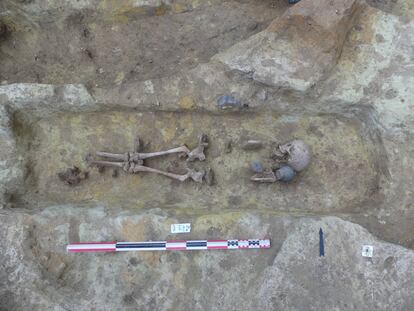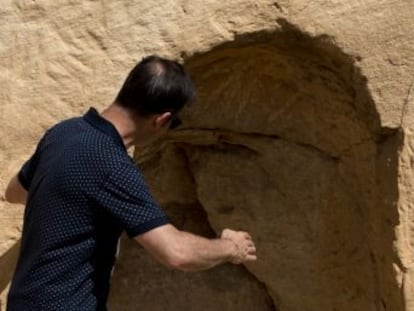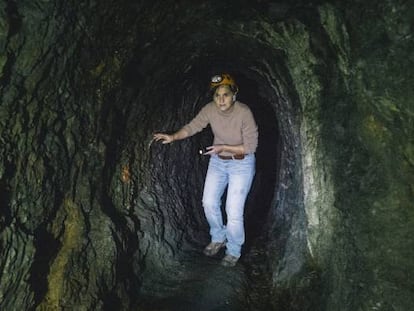Archaeologists uncover 2,000-year-old graves in the heart of Paris
The planned expansion of a Paris train station has led to the discovery of skeletons, offerings, and ceramic and glass objects

More than 2,000 years ago, the Gallo-Roman town of Lutetia lay where the Notre Dame cathedral stands today, on Paris’ Île de la Cité. The settlement stretched out onto the south bank of the river Seine, with paved roadways, impressive monuments and necropolises. Today, remains of that period can still be found in the French capital, as recent preventive excavations carried out ahead of a planned train-station expansion have shown.
In the heart of Paris, three meters beneath the surface, archaeologists located 50 second-century graves in March – a discovery that will offer further insight into the funeral practices of the Parisii, the Gallic tribe that inhabited Lutetia. In the process, we will also get to know a little bit more about how they lived.
The skeletons found belong to men, women and children. “Drawing on their funeral rites, we can reach a kind of general vision of the people who lived in Paris in the second century,” Dominique Garcia, president of France’s National Institute of Preventive Archaeological Research (INRAP), told the French broadcaster Europe 1. The area of land excavated is some 200m2 in size, but the cemetery in which the graves were buried, the Saint-Jacques necropolis, was much bigger. At Lutetia’s zenith, when the town’s population rose to as high as 10,000, it grew to a size of around four hectares.

The Saint-Jacques necropolis was discovered in the 19th century. At that time, archaeologists found that the Parisii, who lived under Roman rule, burned their dead, sometimes placing them on gurneys or in coffins made of wood. The cemetery, it was concluded, was used regularly between the first and third centuries. But scientists in the 19th century were chiefly interested in objects of value, and ignored the skeletons they found, as well as other items that could provide information about the context of the time. The newly-discovered grave site was reconcealed and forgotten about.
Located by the Port-Royal station, the 50 graves have brought Paris’ ancient history back into focus. “What’s so exceptional about this is that we have a window into our past, which is quite rare in this city,” Garcia stresses. The burial sites were preserved despite the construction of numerous pieces of infrastructure in the 1970s, such as a local railway line.
The skeletons found were all burned in wooden coffins, of which only the nails and some small traces of wood remain, INRAP said in a statement. Almost half of the graves were found with objects constituting offerings. In one, for example, a black ceramic vase had been placed between the knees of the deceased. In another, ceramic receptacles had been positioned at the feet of the dead person. Researchers have found cups, plates and jugs, plus glassware. They have also discovered coins, which had been placed inside coffins or in the mouth of the deceased – an offering known as “Charon’s obol.” In Greek mythology, Charon is the ferryman who carried souls across the river Styx to the world of the dead.

In some graves, nails from the soles of shoes have survived, while other objects found include fibulas – pins that were used to hold garments together – and jewels, belts and even hairpins. “At that time, the feeling was that there was another life after death, so people placed things in the grave that would help the dead person to survive in the afterlife,” Garcia says. “That’s why objects from everyday life have been found, as well as pitchers that very likely contained food.”
Archaeologists also discovered the skeleton of a pig and another smaller animal, in a grave additionally containing two receptacles. These are likewise believed to be offerings aimed at ensuring the deceased’s survival in the afterlife.
In addition to seeking an understanding of the daily lives of the Parisii through their funeral practices, researchers also plan to send their findings to a laboratory, where DNA testing will offer information about people’s health during the period.
Sign up for our weekly newsletter to get more English-language news coverage from EL PAÍS USA Edition
Tu suscripción se está usando en otro dispositivo
¿Quieres añadir otro usuario a tu suscripción?
Si continúas leyendo en este dispositivo, no se podrá leer en el otro.
FlechaTu suscripción se está usando en otro dispositivo y solo puedes acceder a EL PAÍS desde un dispositivo a la vez.
Si quieres compartir tu cuenta, cambia tu suscripción a la modalidad Premium, así podrás añadir otro usuario. Cada uno accederá con su propia cuenta de email, lo que os permitirá personalizar vuestra experiencia en EL PAÍS.
¿Tienes una suscripción de empresa? Accede aquí para contratar más cuentas.
En el caso de no saber quién está usando tu cuenta, te recomendamos cambiar tu contraseña aquí.
Si decides continuar compartiendo tu cuenta, este mensaje se mostrará en tu dispositivo y en el de la otra persona que está usando tu cuenta de forma indefinida, afectando a tu experiencia de lectura. Puedes consultar aquí los términos y condiciones de la suscripción digital.
More information
Archived In
Últimas noticias
David Bowie, the galactic thinker who encouraged us to break new ground
John Berger and the loss of rural culture
From police officer to bloodthirsty kidnapper: Terror in Mexico during the years of ‘The Ear Chopper’
Alain Aspect, Nobel laureate in physics: ‘Einstein was so smart that he would have had to recognize quantum entanglement’
Most viewed
- David King, chemist: ‘There are scientists studying how to cool the planet; nobody should stop these experiments from happening’
- Reinhard Genzel, Nobel laureate in physics: ‘One-minute videos will never give you the truth’
- Oona Chaplin: ‘I told James Cameron that I was living in a treehouse and starting a permaculture project with a friend’
- Mexico completes its trade shift with the entry into force of tariffs on China and countries without trade agreements
- Sinaloa Cartel war is taking its toll on Los Chapitos











































